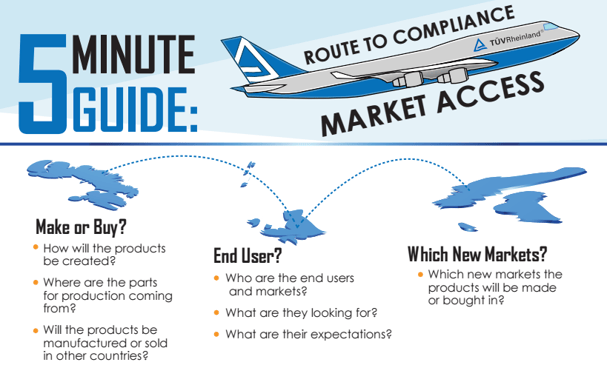As companies are considering exploring new markets outside of their home country, they will be faced with many decisions. It’s important for companies to understand both the opportunities and challenges of taking their products to global markets so they can make better decisions around production, finances, operations and marketing.
What are the benefits of exploring market access?
While there are certainly challenges in entering new global markets, there can also be many benefits and rewards. These primarily include: faster time to market, increased sales and greater profits.
What should companies consider?
A few factors that companies should keep in mind when considering market access include:
- Whether or not to Make or Buy? – How will the products be created? Where are the parts for production coming from? Will the products be manufactured or sold in other countries?
- Who is the End User? – Companies need to invest in appropriate marketing research to identify the end user profile and markets. What are they looking for? What are their expectations?
- Which New Markets? – As companies determine the end user and production considerations, they should determine in which new markets the products will be available?
Quick Tips, Things to Know
While the decision to take the products into new markets may be very complex, there are ways to ease the process. First, you can utilize a partner like TUV Rheinland, who can guide you through your project. It’s so important to understand all considerations and requirements to be prepared for market entry. Utilizing a global partner ensures you have expertise in every area of the world. Our experts have compiled a list of tips to consider for your market access project:
- Make sure to understand the country requirements (i.e. Harmonized Tariff Code).
- Understand the importance of documentation and local/legal representative can assist and support.
- Prepare materials in the required languages for each market. Countries have different preferences and mandates about which languages are used.
- Understand certification requirements for each country. Each country has its own certification and legal requirements. Rely on a local representative to understand and help prepare.
- The required costs may differ depending on the region. As part of preparing to enter a new market, companies should do extensive research of what the required financial investments.
- Make sure to have enough samples for in country testing. Countries may approach in-country testing differently.
- The best time to consider market access is during the Design Phase, when resources are typically being allocated.
- Lead times may differ. It could be 10 days, or even up to a year, depending on the country.
Make sure to understand Certificate Longevity (how long the certificate will last).
For more information on our market access solutions in Asia-Pacific, please visit our website or contact us to speak to one of our experts.




